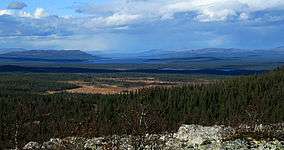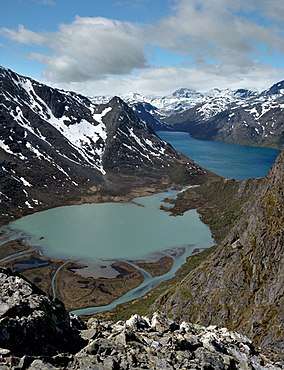Femundsmarka National Park
Femundsmarka National Park (Norwegian: Femundsmarka nasjonalpark) is a national park in Hedmark and Trøndelag counties in Norway. The landscape is largely marshes and lakes (it lies adjacent to Norway's second largest natural lake, Femunden). It is a popular destination for canoeing and fishing. The park was formed in 1971 to protect the lake and the forests stretching eastwards to Sweden. Indeed, the landscapes here are more Swedish in appearance than recognisably Norwegian. The forest is sparse and consists of craggy pine and birch.
| Femundsmarka National Park | |
|---|---|
IUCN category II (national park) | |
 | |
 | |
| Location | Hedmark and Trøndelag, Norway |
| Nearest city | Røros |
| Coordinates | 62°13′N 12°7′E |
| Area | 573 km2 (221 sq mi) |
| Established | 1971 |
| Governing body | Directorate for Nature Management |
The park has long been a source of falcons for use in the European and Asian sport of falconry and several places in the park are known as Falkfangerhøgda, or "falcon hunters' height". There are also wild reindeer grazing in the heights and, in summer, a herd of around 30 musk oxen roam the area along the Røa and Mugga Rivers (in winter they migrate to the Funäsdalen area). This group split off from an older herd in the Dovrefjell area and migrated here.[1]
The National Park influenced the name of the album Femundsmarka of the German black metal band Waldgeflüster.
Name
The first element is the genitive of the lake name Femund and the last element is the finite form of mark which means "woodland" or "forest".
References
- "Femundsmarka National Park". Retrieved 2011-02-25.
External links
- Virtual 360° Tour of Femundsmarka National Park
- Map of Femundsmarka National Park
- Femundsmarka - nine protected nature areas
